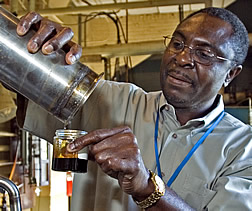This page has been archived and is being provided for reference purposes only. The page is no longer being updated, and therefore, links on the page may be invalid.
|
|
ARS Bio-Oil Technology Heats Up
By Laura McGinnisApril 6, 2007
Biofuels are a hot commodity—and thermochemical processing is making them even hotter. New research by Agricultural Research Service (ARS) scientists could soon lead to improved techniques for producing bio-oils.
At the ARS Eastern Regional Research Center (ERRC) in Wyndmoor, Pa., scientists are exploring different methods for making fuels from biomass, which includes materials such as energy crops, corn stover and straw.
The conversion method known as thermochemical processing involves heating the biomass in a reactor to produce liquids (bio-oils) and synthetic gases (gaseous fuels such as hydrogen and methane).
At the ERRC, chemical engineer Akwasi A. Boateng and mechanical engineer Neil M. Goldberg, working with Daren E. Daugaard of the University of Texas-San Antonio, have developed a bench-scale fluidized bed reactor to convert switchgrass and other energy crops into bio-oil in a process called pyrolysis. This method uses extreme heat to break down organic materials in an oxygen-free environment.
One advantage of the reactor is that it demonstrates the potential of in-field conversion of biomass into oil. The resulting oil is more energy-dense than the original biomass, so transporting oil from the field to a central refinery is more economical than moving hay or biomass pellets.
The bench-scale reactor maximizes liquid yield collection by incorporating an electrostatic precipitator (ESP), a filtering device that removes fine liquid droplets from the gas flow. The bio-oil derived from the ESP has several desirable properties, including relatively low water content, resulting in higher energy density and superior transportability.
The oil collected by the ESP is suitable as a feedstock, because the oil's energy density is higher than the average collected bio-oil. Further refining can turn this oil into a more standard diesel fuel for use in automobiles, farm equipment and other diesel-run machines.
Read more about this and other ARS bioenergy research in the April 2007 issue of Agricultural Research magazine.
ARS is the U.S. Department of Agriculture's chief in-house scientific research agency.

